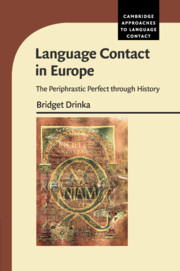Book contents
- Frontmatter
- Contents
- Series Editor's Foreword
- Acknowledgments
- Abbreviations, Based on the Leipzig Glossing Rules
- 1 Language Contact in Europe: The Periphrastic Perfect through History
- 2 Languages in Contact, Areal Linguistics, and the Perfect
- 3 The Perfect as a Category
- 4 Sources of the Perfect in Indo- European
- 5 The Periphrastic Perfect in Greek
- 6 The Periphrastic Perfect in Latin
- 7 The Charlemagne Sprachbund and the Periphrastic Perfects
- 8 The Core and Peripheral Features of the Romance Languages
- 9 The Early Development of the Perfect in the Germanic Languages
- 10 The Semantic Shift of Anterior to Preterite
- 11 The Balkan Perfects: Grammaticalization and Contact
- 12 Byzantium, Orthodoxy, and Old Church Slavonic
- 13 The l- perfect in North Slavic
- 14 Updating the Notion of Sprachbund: New Resultatives and the Circum- Baltic “Stratifi ed Convergence Zone”
- 15 The have Resultative in North Slavic and Baltic
- 16 Conclusions
- Notes
- Bibliography
- Index
4 - Sources of the Perfect in Indo- European
Published online by Cambridge University Press: 23 February 2017
- Frontmatter
- Contents
- Series Editor's Foreword
- Acknowledgments
- Abbreviations, Based on the Leipzig Glossing Rules
- 1 Language Contact in Europe: The Periphrastic Perfect through History
- 2 Languages in Contact, Areal Linguistics, and the Perfect
- 3 The Perfect as a Category
- 4 Sources of the Perfect in Indo- European
- 5 The Periphrastic Perfect in Greek
- 6 The Periphrastic Perfect in Latin
- 7 The Charlemagne Sprachbund and the Periphrastic Perfects
- 8 The Core and Peripheral Features of the Romance Languages
- 9 The Early Development of the Perfect in the Germanic Languages
- 10 The Semantic Shift of Anterior to Preterite
- 11 The Balkan Perfects: Grammaticalization and Contact
- 12 Byzantium, Orthodoxy, and Old Church Slavonic
- 13 The l- perfect in North Slavic
- 14 Updating the Notion of Sprachbund: New Resultatives and the Circum- Baltic “Stratifi ed Convergence Zone”
- 15 The have Resultative in North Slavic and Baltic
- 16 Conclusions
- Notes
- Bibliography
- Index
Summary
In his insightful analysis of the perfects of Europe, Jouko Lindstedt (2000: 368) remarks that perfects in the languages of the world are usually periphrastic in form, but that a notable exception to this tendency exists in the old perfects of Indo-European, especially as represented by Classical Greek and Sanskrit. To this observation can be added the fact that many Indo-European languages have developed a periphrastic perfect, either as a direct replacement of the IE synthetic perfect or as a complementary addition to the verb system. Why should it be that the old, synthetic perfect of IE came to be replaced by analytic structures in so many IE languages? Why did these periphrastic structures tend to be formed with stative auxiliaries and past passive participles, as illustrated in Chapter 3, at a rate much higher than that found for perfects of other languages? What role did Proto-Indo-European, the earliest reconstructable ancestor of virtually all European languages, play in this rise of the periphrastic perfects of Europe?
In previous chapters, it was claimed that the configuration of components available to speakers of Indo-European languages enabled and even encouraged this development. In Chapter 2, it was hypothesized that the development of the meaning of later periphrastic constructions – resultatives, passives, and perfects – was set in motion by the passive and anterior value of participles and verbal adjectives inherited from the proto-language. In Chapter 3, it was concluded that the use of HAVE as an auxiliary was surely encouraged by the presence of the participle or verbal adjective inherited from PIE. In this and in following chapters, we will expand on these claims, exploring the semantic value and formal features of the oldest perfects in an attempt to discover whether the structures of PIE actually did predetermine the outcome of periphrastic structures in Europe and the extent to which this development was influenced by the interplay of auxiliary and participle.
- Type
- Chapter
- Information
- Language Contact in EuropeThe Periphrastic Perfect through History, pp. 73 - 93Publisher: Cambridge University PressPrint publication year: 2017



